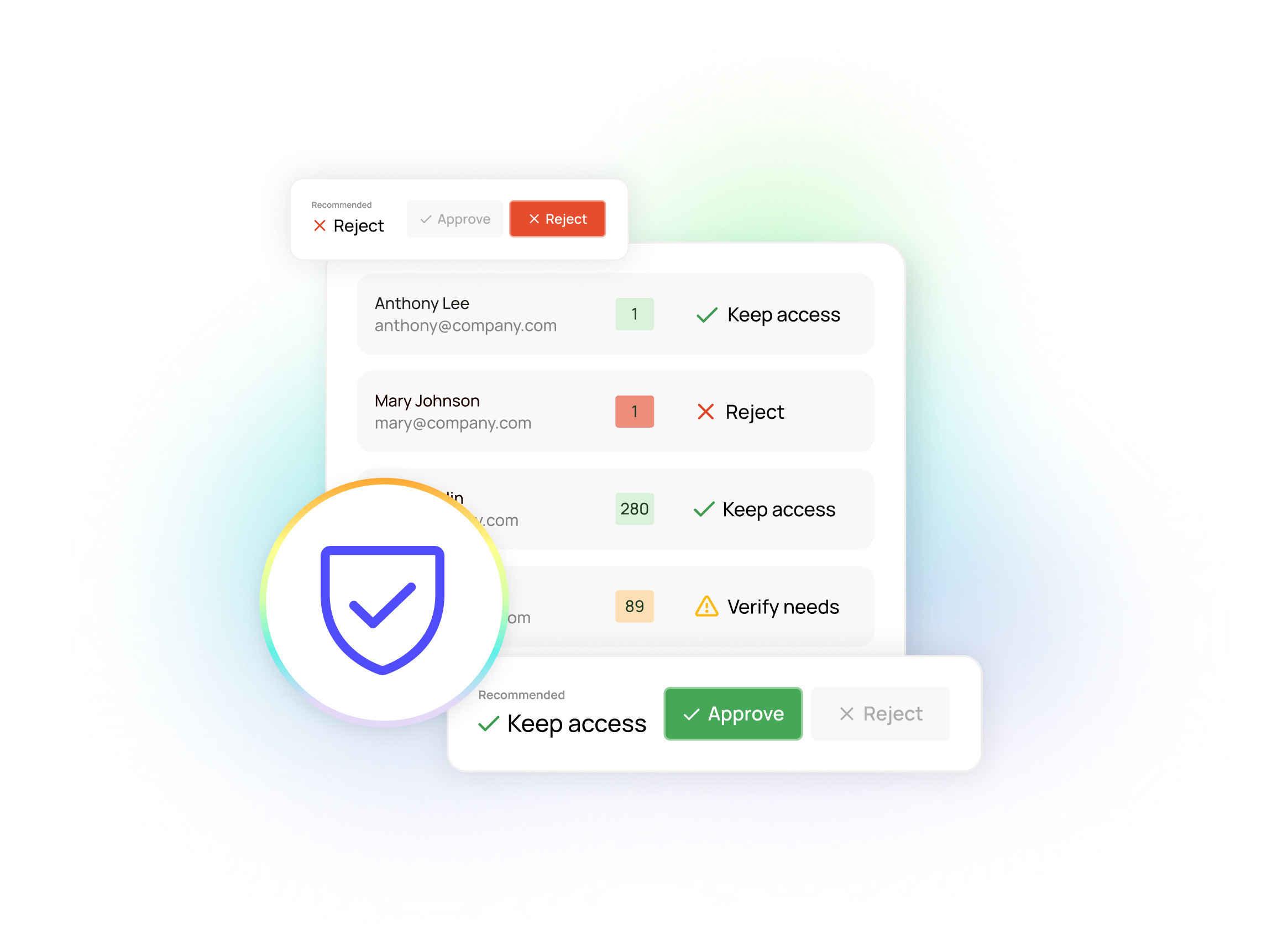Blog

How Oleria's Trustfusion Platform accelerates identity maturity
Every CISO and security leader has heard the statistics: 80% of breaches involve compromised identities1, and identity-based attacks are spiking 77% year-over-year2. But those numbers only tell the scary story of the worst-case outcomes — they don’t capture the day-to-day operational reality of everything CISOs and security teams do to try to avoid those worst-case outcomes: the endless frustration of managing identity across fragmented systems that were never designed for the speed, scale, and complexity of today’s business world (to say nothing of tomorrow’s agentic AI-enabled future).
This operational reality is tediously manual. Annoyingly repetitive. Maddeningly slow. And it’s keeping businesses from innovating at full speed. In other words, the urgent need to transform identity architecture is not only about mitigating breach risks — it’s just as much about unlocking greater speed and agility for the business.
Defining the path forward: The five stages of identity maturity
Last summer at the SINET Risk Executive Workshop, our CEO Jim Alkove joined a group of leading CISOs in forming the SINET Identity Working Group. I got to be part of that group as we homed in on this critical challenge — providing a roadmap for how organizations can achieve a smooth and complete identity transformation. First introduced in the Managing Identity in the Age of AI guide, that roadmap takes the tried-and-true form of a maturity model, providing a prescriptive, structured pathway from their current fragmented state to a bold vision for a unified identity and access architecture.
The identity maturity model measures essential capabilities across 12 core identity areas through five distinct maturity levels. You can access the full maturity model here, but let’s focus on the distinct levels and how organizations can benchmark their current state.

- Initial: Characterized by poor visibility, ad-hoc processes, no systematic governance, a reactive approach to identity issues, and a highly vulnerable posture to identity-based attacks.
- Developing: Basic visibility into key identity elements established, along with foundational management processes. Central governance team identified to begin developing standardized policies. While the response to identity issues remains largely reactive, some early automation reduces immediate vulnerabilities. But significant gaps remain for comprehensive control and strong posture.
- Defined: Improved visibility and understanding achieved through documented processes and a degree of integration between identity systems. Governance policies established, but policies are infrequently and sporadically enforced. Consistent management processes are in place with moderate automation. This allows for more coordinated response to identity issues, moving toward proactive measures — and improves posture.
- Managed: Offers near real-time visibility and comprehensive understanding across the identity ecosystem through unified systems and data collection. Governance policies are continuously enforced by the governance team. Highly automated and mature management processes enable proactive identity risk identification, significantly strengthening posture against identity-based threats.
- Optimized: Achieves continuous, intelligent visibility and predictive understanding powered by advanced analytics and AI. Autonomous systems detect the need for policy changes and the governance team drives proactive conformance of policies. Autonomous and self-healing management processes drive continuous improvement, leading to a highly adaptive and proactive threat response model and an exceptionally resilient posture.
Oleria brings the unified identity platform to life
As the Identity Working Group developed our vision for a unified identity and access platform, it was encouraging to see how that vision perfectly aligns with the platform and applications that we’ve built at Oleria: data-centric and AI-ready solutions designed from the ground up to provide full clarity and control over all access for all identities — human, non-human, and AI — across your entire hybrid environment: SaaS, cloud, on-premises, and custom applications. We’ve taken a unique approach to redefining the core identity technology that organizations need to enable tomorrow’s business advantages:
- Graph-native architecture: Our graph-native Trustfusion Platform connects HR/vendor data, identities, accounts, groups, roles, and permissions to applications, down to individual resources — and enriches them with permission-level usage data to provide continuous insights for faster, more adaptive identity security across your evolving digital estate. This modern architecture unifies distributed identity, access, resource and activity into a common schema and ontology, built out into a composite graph, that reveals critical context that traditional tools miss entirely.
- AI-driven intelligence that transforms operations: Through constant contextual learning, we transform security operations from reactive to proactive, starting with your security posture. We elevate it to provide comprehensive risk assessment, automated case summarization with Oleria's Copilot, and actionable recommendations that materially strengthen your posture. We turn manual, complex governance processes into autonomous governance with intelligent, intuitive, and automated workflows. This continuously enforces least-privileged access by giving the right user the right access to the right resources at the right time, boosting compliance and efficiency.
- Integrated AI capabilities: AI seamlessly woven into the platform architecture enables continuous risk analysis, automated recommendations, and intelligent workflows with pinpoint accuracy based on unique usage data that only Oleria's unified approach can provide.
How Oleria accelerates identity maturity progression
The unique and transformative capabilities of Oleria’s Trustfusion Platform are already enabling organizations to accelerate their progression through identity maturity stages. Here's how our platform advances identity maturity:
Foundation building: Initial to Developing
Current state challenges: Partial inventory, ad-hoc processes, single weak factor authentication, and no formal governance structure.
Oleria platform capabilities that accelerate transformation:
- Posture dashboard & access inventory: Complete identity inventory across all systems within hours — or even minutes— moving from partial ad-hoc inventory to critical assets inventoried with repeatable processes. Provides immediate visibility into human and non-human identities across your entire hybrid environment.
- Authentication hygiene: Continuous visibility into authentication strength gaps to help identify weak or outdated authentication methods and enable transition toward strong, phishing-resistant MFA.
- Authorization hygiene: Automatic detection of unused, dormant, or unintended access to help identify excessive privileges and enforce least-privilege principles.
- External Accounts & external sharing: Automated discovery of all external accounts and shared resources, including risky external sharing where you can’t control authentication hygiene, such as employee self-sharing to personal accounts and dormant third-party access that’s no longer needed.
- Access Graph: Accelerating targeted investigation and risk remediation with a unified, visually intuitive map of all identity relationships — including accounts, groups, permissions, and resources — across identity providers, cloud infrastructure, legacy systems, and SaaS apps. Visibility down to the individual resource level makes it easy to see where critical files live, how access was gained, and what actions were taken.
Process standardization: Developing to Defined
Current state challenges: Basic lifecycle processes, limited automation, disjoint systems, and manual audit processes.
Oleria platform capabilities that enable consistency:
- Access inventory & risk monitoring: Progress from highest-value identity and access inventory to full inventory (including human, non-human, and AI identities) with automated processes and credential rotation monitoring. Comprehensive visibility into machine identities and service accounts.
- Governance overview & automated workflows: Transform basic governance roles into established governance teams with documented audit processes and comprehensive tracking. Provides centralized policy management and enforcement.
- Access reviews with intelligent recommendations: Move from on-demand access reviews to regular, scoped audits with automated campaigns that achieve high fix rates. AI-powered recommendations based on actual usage patterns significantly reduces manual review time.
Comprehensive automation: Defined to Managed
Current state challenges: Most assets inventoried with partially automated processes, but lacking continuous monitoring and real-time threat detection.
Oleria platform capabilities that enable advanced operations:
- Continuous access monitoring: Achieve comprehensive access reviews with continuous monitoring, driving towards least privilege through usage-based intelligence. Real-time analysis of access patterns across your entire digital estate.
- Streamlined compliance reporting: Transform manual audit processes by generating compliance evidence based on comprehensive, detailed audit trails. Supports SOX, HIPAA, PCI DSS, and other regulatory frameworks.
- Accelerating identity threat investigation & response: Eliminate slow, manual ITDR workflows by bringing all identity and access information into one place to deploy advanced analytics and ML detection with behavioral intelligence to see what a breached account can access, what resources were accessed, and what actions were taken — for faster containment and remediation.
Autonomous operations: Managed to Optimized
Current state vision: Oleria’s vision is to deliver an adaptive, agentic, and fully autonomous identity solution — one that evolves in step with the rapidly advancing capabilities of agentic AI. We’re working side-by-side with our customers to make that vision a reality with our Trustfusion Platform as the foundation that delivers a complete identity inventory, fully automated processes, continuous validation, and will enable AI-driven governance for the “self-healing system” that anticipates and responds to risk in real time.
Why platform architecture matters
The capabilities of the Oleria platform enable organizations to advance through the identity maturity stages — but it’s our unique platform architecture that gives organizations a speed advantage over other approaches and solutions:
- Rapid deployment: Full integration within days across hybrid environments, providing immediate visibility and intelligent governance into identity systems — unlike conventional IGA solutions requiring months of setup.
- Unified data: A single source of truth eliminates conflicting information and ensures consistent policy enforcement, creating a foundation for enhanced maturity.
- Continuous intelligence: Real-time monitoring and analytics analyze access patterns across your digital estate, enabling proactive threat detection and automated privilege optimization.
- Scalable architecture: Connect seamlessly via robust APIs and MCP server across all environments for comprehensive access management.
Accelerating your path forward
The path to identity maturity begins with understanding your current state and systematically building toward autonomous operations. Organizations that act now — powered by Oleria's unified platform architecture — will emerge as leaders in the secure, AI-enabled future of business.
Take the first step toward autonomous identity management today.
Our comprehensive identity maturity assessment benchmarks your current capabilities across all 12 critical domains and provides a clear roadmap for advancement. Our expert team will help you identify immediate opportunities for risk reduction while building a robust foundation for long-term transformation. The assessment includes:
- Comprehensive evaluation across all maturity domains
- Prioritized roadmap with specific implementation timelines
- Strategies to systematically reduce attack surfaces and build more resilient defenses
- Customized demonstration of Oleria's platform capabilities
Visit www.oleria.com/identity to begin your identity transformation.
1 CrowdStrike Global Threat Report
2 IBM Cost of a Data Breach 2023

Access reviews are broken, but they don’t have to stay that way

Access reviews are broken, but they don’t have to stay that way

How Oleria's Trustfusion Platform accelerates identity maturity

How Oleria's Trustfusion Platform accelerates identity maturity
.png)
Managing Identity in the age of AI
.png)
Managing Identity in the age of AI
.png)
Our vision for the future of identity security? It’s already in motion.
.png)
Our vision for the future of identity security? It’s already in motion.
.png)
Solving the non-human identity (NHI) crisis with Jim Alkove and Garrett Bekker
.png)
Solving the non-human identity (NHI) crisis with Jim Alkove and Garrett Bekker

A CISO’s take: Enterprise copilot risks with Jim Alkove and Ramy Houssaini

A CISO’s take: Enterprise copilot risks with Jim Alkove and Ramy Houssaini
.png)
2025 RSAC insights: the rapid rise of autonomous identity security
.png)
2025 RSAC insights: the rapid rise of autonomous identity security

Why I am betting on Oleria as the future of identity security

Why I am betting on Oleria as the future of identity security

Google Workspace security best practices: file-sharing

Google Workspace security best practices: file-sharing
.avif)
AI assistants and security gaps: a practical approach for securing Microsoft 365 Copilot
.avif)
AI assistants and security gaps: a practical approach for securing Microsoft 365 Copilot



.avif)